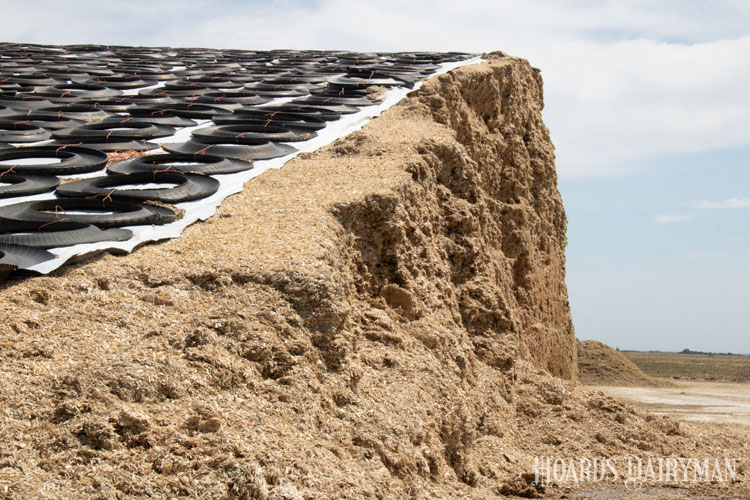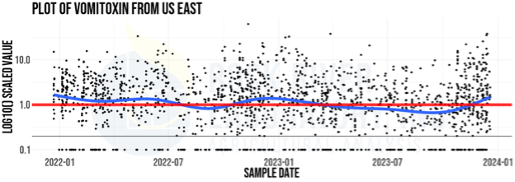
Forage management and feed hygiene are back to being front and center. Over the past couple years, growing conditions coupled with advances in seed genetics, agronomic practices, and crop protection have equated to cleaner feed and healthier cows.
Speaking to the growing conditions, the past crop year undoubtedly has a substantial impact on feed quality. With plant disease, the growing environment temperature and moisture levels impact both the disease-causing inoculum in crop residue and soils and later, the ear and stalk rot or tar spot growth potential. As we get deeper into feeding forage and grain grown in 2023, there must have been growing conditions conducive to plant disease in some regions as we’re recognizing sporadic mycotoxin and feed hygiene issues from Michigan to New York.
At this point, it’s unclear how far and wide plant disease and substantial mycotoxin contamination are present, but questions and discussion have picked up. I’ll credit a couple nutritionists with helping me zero in on the topic as they started to notice rising vomitoxin levels in recently chopped corn and then reached out to me.
As we delve into this topic, take to heart one aim here is raising awareness. Another more important objective is helping you think through short-term and long-term strategies if your farm is faced with feed hygiene challenges.
What can be done?
Admittedly, I stand to learn more from agronomists in potentially afflicted regions. Though in my limited conversations with agronomists, ear or stalk rot and crop disease weren’t readily apparent this year in some fields where we are still finding mycotoxin contamination in feeds from these fields that looked visibly healthy. For example, one agronomist reached out for help understanding why zearalenone is showing up at increasing levels the past few years despite visibly healthy fields. As always, University of Wisconsin-Madison’s Damon Smith has insights to help us rationalize this outcome and continues to improve my understanding of crop disease and mycotoxin accumulation.
Smith shared that asymptomatic infections are possible. In these situations, plant disease is happening but the infection isn’t visibly apparent in the plants. Then, with undetected fungal growth, mycotoxins can accumulate. Initially this concept was hard for me to grasp, but it helped explain several situations over the past few years.
Now with feed in silos and grain in bins, we’re watching for trends and putting solutions in place where needed. Vomitoxin levels appear to have slightly risen in samples submitted to Rock River Laboratory Inc’s eastern locations. Trendlines can be misleading, but consultant Neil Micheal taught me years ago that the number of observations on the high or low end of the spectrum can also be informative.
With this evaluation mindset from samples taken in the eastern U.S., note that there are considerably more samples with 5 to 10 or more parts per million (ppm) of vomitoxin levels in the past month or two relative to the past year. Step one is recognition, steps two and beyond are mitigating the issue. Thankfully these feed ingredient and management solutions listed below help us maintain herd health and performance:
- Dilute the mycotoxin contaminated feed to maintain less than 1 ppm vomitoxin in the TMR. Monitor TMR mycotoxin levels to confirm the strategy is working.
- Monitor corn-based commodity feeds such as corn distillers grains or corn gluten feed.
- Avoid feeding highly contaminated feed to transition and peak cows.
- Add a research-backed mycotoxin mitigation feed ingredient or technology into the diet.
- Add research-backed immune system stimulating or probiotic solutions that enhance animal health to counter negative health effects associated with mycotoxins.
Beyond mycotoxins, bear in mind that feed hygiene challenges are often multi-faceted and represent an intersection between veterinary and nutritional science. Spoilage yeast continues to be an underrecognized rumen disruptor, and we’re increasingly recognizing undesirable bacterial contamination in digestive upset cases.
Figure 1: Vomitoxin concentration in feed samples analyzed by Rock River Laboratory Inc. over the past two years for Eastern U.S. samples.

Look for an upcoming “Feeding Fundamentals” article in Hoard’s Dairyman expanding on the topic and concepts here and further discussing the interactions between agronomy, veterinary, and nutritional science regarding feed hygiene. I’ll also be back on the speaking trail with a couple sessions in coming months delving into this topic. The long term goal is to help you and other producers continue making gains toward cleaner feed and more efficient dairy herd production.








